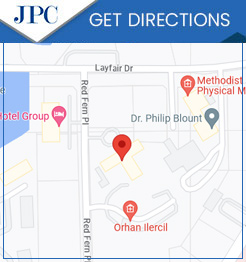Peripheral Nerve Block Specialist in Flowood, MS
A peripheral nerve block is a medical technique used to treat pain by injecting a local anesthetic or other medications into particular nerves. At Jackson Pain Center, board-certified Dr. J. Edwin Dodd offers peripheral nerve block treatment to prevent the brain from receiving pain signals and relieve pain and other symptoms. Peripheral nerve blocks can treat typical symptoms of related conditions, including neuropathy, such as pain, numbness, weakness, and improved muscle strength. Peripheral nerve blocks offer efficient pain relief, fewer side effects, tailored treatment, and a decreased need for additional painkillers. For more information, contact us or schedule an appointment online. We are conveniently located at 1 Layfair Drive, Suite 400 Flowood, MS 39232.


Table of Contents:
How long is a nerve block supposed to last?
What is the procedure for a nerve block?
Can a nerve block be permanent?
How Are Nerve Blocks Used?
There are two types of nerve blocks: non-surgical and surgical. Non-surgical nerve blocks are used in surgery to provide a temporary, regional anesthetic to a particular area, effectively blocking pain. This type of nerve block usually lasts longer than a local anesthetic. However, it may not last long enough for extensive procedures to be completed, and you could require multiple injections.
Typically, a non-surgical nerve block wears off in twelve to thirty-six hours; however, some patients may still feel the effects forty-eight hours after administration. On the other hand, surgical nerve blocks are a specific procedure in which a nerve or nerve bundles are purposefully damaged to provide long-term or permanent pain relief. The effects of a surgical nerve block could last weeks or be permanent.
A nerve block may be a procedure on its own (surgical) or used as a regional anesthetic for an unrelated surgery (non-surgical). There are many different types of nerve blocks used in both instances. For example, in a surgical sympathetic blockade, a medication is injected into the sympathetic ganglia, a collection of nerves extending off of the spine, to cause damage to render the nerve ineffective in pain signaling. Similarly, a rhizotomy is performed to damage the root of nerves as they extend off of the spinal cord.
Another kind of surgical nerve block procedure, a neurectomy, is the removal of parts or whole peripheral (outside of the brain and spinal cord) nerves. In the case of a non-surgical nerve block, injection of various medications at different nerve sites serves anesthetic benefits for surgical procedures. A sympathetic blockade can also be non-surgical, in which injection to a major nerve or nerve bundle results in numbing across a large area of the body.
Alternatively, a peripheral nerve block targets a specific nerve to provide pain relief in a smaller, more focused area. An epidural is commonly known for its usage in laboring mothers, though it may also be used for other surgical procedures. Here, an analgesic (pain-relieving medication) or corticosteroid (anti-inflammatory) is injected into a space around the spinal cord, called the epidural space, to block the pain from the lower part of the body. However, a spinal nerve block differs from an epidural as the medication is injected into the dural sac that contains the spine and a protective fluid, called cerebrospinal fluid, and can almost immediately be felt over the whole body.
Whether your nerve block is surgical or non-surgical, your doctor will likely inject a contrast dye and use fluoroscopy or other medical imaging technology to ensure the nerve block is injected in the correct location. These medications are meant to be injected close to a nerve, allowing for a focused absorption of the medicine. If your doctor is injecting near a larger bundle of nerves or ganglia, they will likely ask you to speak up about any sharp electrical pains you feel, as this means their needle has touched a nerve.
Patients will likely be given a sedative beforehand by pill or continuously through an intravenous (IV) line to calm patient’s anxiety and further reduce pain. Nerve blocks have the potential to cause severe changes in the body, so your medical team will be closely monitoring your vitals.
This includes your blood pressure, heart rate, rhythm, respiration (breathing) rate, blood oxygen saturation, temperature, etc. Surgical nerve blocks are performed on an outpatient basis, and the complete procedure, from preparation and recovery, will take less than an hour or so.
Non-surgical nerve blocks used to replace a local anesthetic usually wear off within forty-eight hours, though a surgical nerve block is performed to provide long-term symptom relief. Though the success rate is not 100%, most surgical nerve blocks can provide permanent pain relief.
Most nerve blocks, non-surgical and surgical, utilize the injection of various medications around a specific nerve or nerve bundle to provide pain relief or regional anesthesia. Non-surgical nerve blocks are most commonly used for surgeries on the legs, arms, hands, feet, or face and can numb a small and focused area or a large area. Nerve blocks sometimes are used instead of a local anesthetic for surgeries over a large area, as high or prolonged doses of local anesthetics come with many side effects. In addition, for those experiencing pain and inflammation, nerve block injections can be used to diagnose and treat the problem.
Our specialized medical care team here at Jackson Pain Center feels strongly about aiding our patients in their recovery from several conditions that cause pain. We strive to vastly improve our patient’s health and quality of life through numerous treatment plans, individualized for their needs. To meet with one of our doctors, please contact us or schedule an appointment online. We are located at 1 Layfair Drive, Suite 400 Flowood, MS 39232. We serve patients from Flowood MS, Jackson MS, Richland MS, Ridgeland MS, Langford MS, Brandon MS, Pearl MS, and the entire central Mississippi area.


Additional Services You May Need
▸ Facet Injections
▸ Cervical Epidural Steroid Injection
▸ Lumbar Epidural Steroid Injections
▸ Radiofrequency Ablation
▸ Celiac Plexus Block
▸ Trigger Point Injections
▸ Caudal Steroid Injection
▸ Occipital Nerve Block
▸ Lumbar Sympathetic Block
▸ Piriformis Muscle Injection
▸ Sphenopalatine Ganglion Block
▸ Sacroiliac Joint Steroid Injection
▸ Fluoroscopically Guided Hip Injection
▸ Stellate Ganglion Block
▸ Lumbar Medial Branch Block
▸ Lumbar Radiofrequency Neurotomy
▸ Cervical Facet Radiofrequency Neurotomy
▸ Thoracic Transforaminal Epidural Steroid Injection
▸ Lumbar Transforaminal Epidural Steroid Injection



